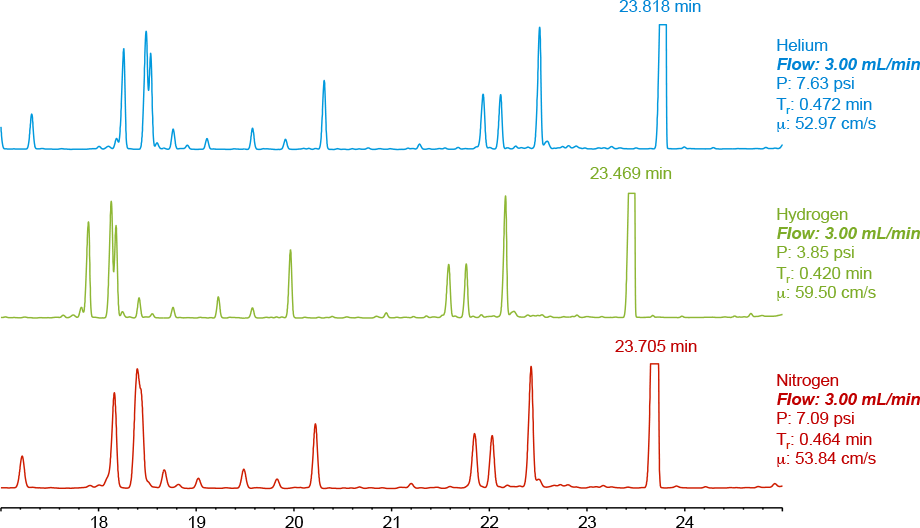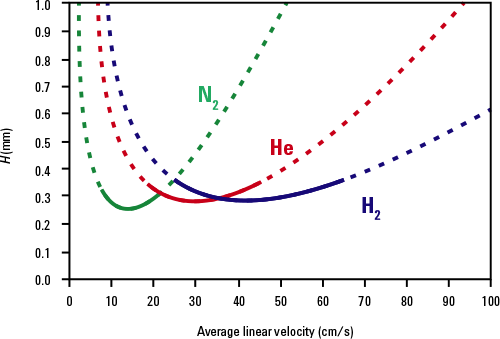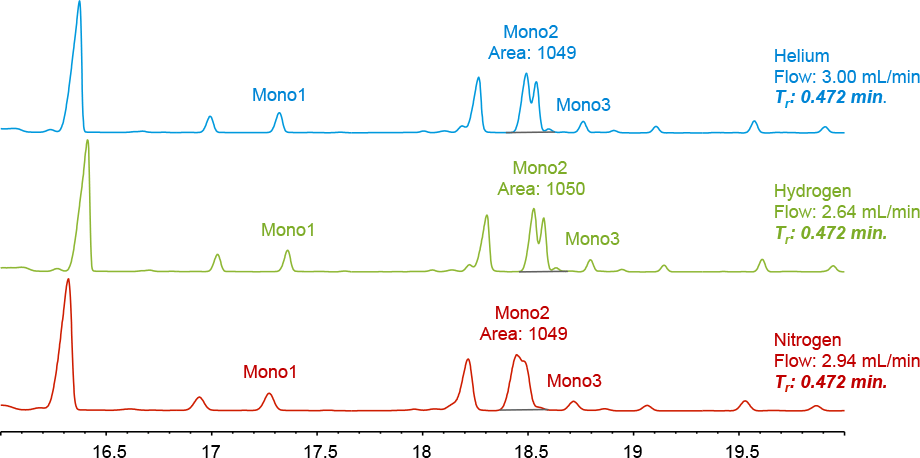Access Agilent eNewsletter, July 2014
>> Update My Profile | Subscribe to Access Agilent | Article Directory
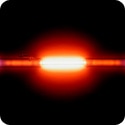
Alternative carrier gases for gas chromatography:
1, 2… 3?
By Jason Ashe
Agilent GC Product Manager
Are you experiencing the helium carrier blues? Is your cost per analysis rising due to increased cost of helium? Have your customers waited for their results because you could not get helium to run your instruments? You are not alone. This article discusses strategies to help you replace helium with a more plentiful carrier gas, or to decrease your helium usage up to 30-fold.
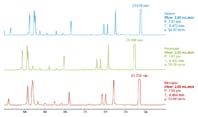 Enlarge
Enlarge
Figure 1. When used at the same flow rate as expensive helium carrier gas, hydrogen and nitrogen produce only slight retention time variations.
Helium is the most logical choice for gas chromatography (GC) carrier gas due to its inertness and physical properties. However, because of helium price and supply concerns, laboratories are successfully implementing alternative carrier gases such as hydrogen and nitrogen. Each gas has its merits and applications where it fits best, but for many methods, any of the three can work effectively. The Agilent 7890B GC can use all three carrier gases (helium, hydrogen, and nitrogen), and Agilent has many applications that show the performance of each gas. (For example, see Figure 1.)
Why the helium shortage?
Helium is a non-flammable, colorless, tasteless, odorless, inert noble gas that is useful in many scientific and manufacturing processes. There are many industries that rely on He which leads to issues with production, storage, and pricing that can affect customers who require its use for their applications. The US Government owns helium reserves that account for seventy-five percent of the global supply. However, the government has enacted legislation that says it will no longer manage the reserves. Instead, it will sell the majority of the stores to private companies within the next ten years. For more information refer to the H.R.527 – Helium Stewardship Act of 2013.
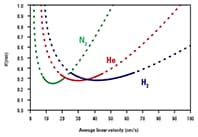 Enlarge
Enlarge
Figure 2. Maximum efficiency shown for each carrier gas.
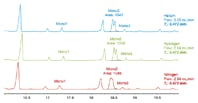 Enlarge
Enlarge
Figure 3. Monoglyceride resolution is sufficient using nitrogen carrier. All monoglycerides are summed for final reporting, so baseline separation of isomers is not required.
Agilent 7890B GC – built-in features for substantial helium conservation
Helium still remains the carrier gas of choice, especially for mass spectrometry applications. Its inherent low reactivity with compounds of interest, coupled with its range of linear velocity (see Figure 2), make it the preferred GC carrier gas. When you use helium, the Agilent 7890B GC can help conserve and operate efficiently, saving helium supply and costs. Agilent offers a Programmable Helium Conservation Module and “Sleep/Wake” functions to help decrease usage by up to thirty-fold compared with a system that does not have this functionality.
Nitrogen carrier: best efficiency, limited average linear velocity
Nitrogen provides the best efficiency (see Figure 2); however, its maximum efficiency is at a fairly low average linear velocity. The steepness of the nitrogen van Deemter curve means that small changes in the average linear velocity result in large changes in efficiency. The reduced average linear velocity leads to longer analysis times, which may not be suitable for higher throughput applications. Also, there is a reduction in peak signals which would not be suitable for low level analysis. But, even with its drawbacks N2 carrier can be used effectively for acrylates, BTEX, alcohols, non-aromatics, monoglycerides (see Figure 3), and light hydrocarbon analyses.
Sensor for use with hydrogen carrier
Another carrier gas that is becoming more popular is hydrogen. However, hydrogen is highly reactive, and many users are concerned about potential combustion. The analytical benefit of hydrogen is the widest range of maximum efficiency (see Figure 2), making its use desirable to decreases analysis times.
The Agilent 7890B GC has an option of a fully integrated hydrogen sensor that shuts down the GC when the oven atmosphere reaches one percent hydrogen. A one percent atmosphere is 25 percent of the lower explosive limit (LEL) for hydrogen. By disrupting hydrogen flow and shutting the GC down, this potentially hazardous condition never occurs. Agilent also offers an accessory to retrofit and upgrade the older Agilent 7890A GC.
Hydrogen carrier is very economical and useful but it has some drawbacks as well. Hydrogen can increase the rate of bleed for certain columns, which in turn may decrease the useful lifetime of the column. Hydrogen is very reactive and can have an effect on analytes such as nitroanalines and nitrophenols, and can create active sites within the analytical flow path. Agilent offers a complete inert flow path to minimize the risk of activation within the system.
Which carrier gas will work for you?
Helium is considered the main carrier gas for gas chromatography and historically works the best for the majority of applications. However, hydrogen and nitrogen do have merit and are worthy of investigation. With the uncertain future of helium costs and supply, laboratories must have contingency plans. When you prove method competence proactively with alternative carrier gases, you reduce the risk of lost analysis time and associated lost revenue.
Because you must optimize methods for the carrier gas of choice, Agilent has developed a method translator that assists with the specific parameter changes needed for carrier gas migration.
To reduce the risks associated with helium shortage, explore more resources for alternative carrier gas solutions and method translators. Then take a moment to expand your knowledge of the Agilent 7890B GC, along with the Agilent Programmable Helium Conservation Module.
In addition, please enjoy our technical presentations:
- Reducing Pressure on Operational Budgets; Helium Conservation Strategies for GC and GC/MSD
- Converting Helium Carrier Gas GC Methods to Nitrogen and Hydrogen
>> Update My Profile | Subscribe to Access Agilent | Article Directory
